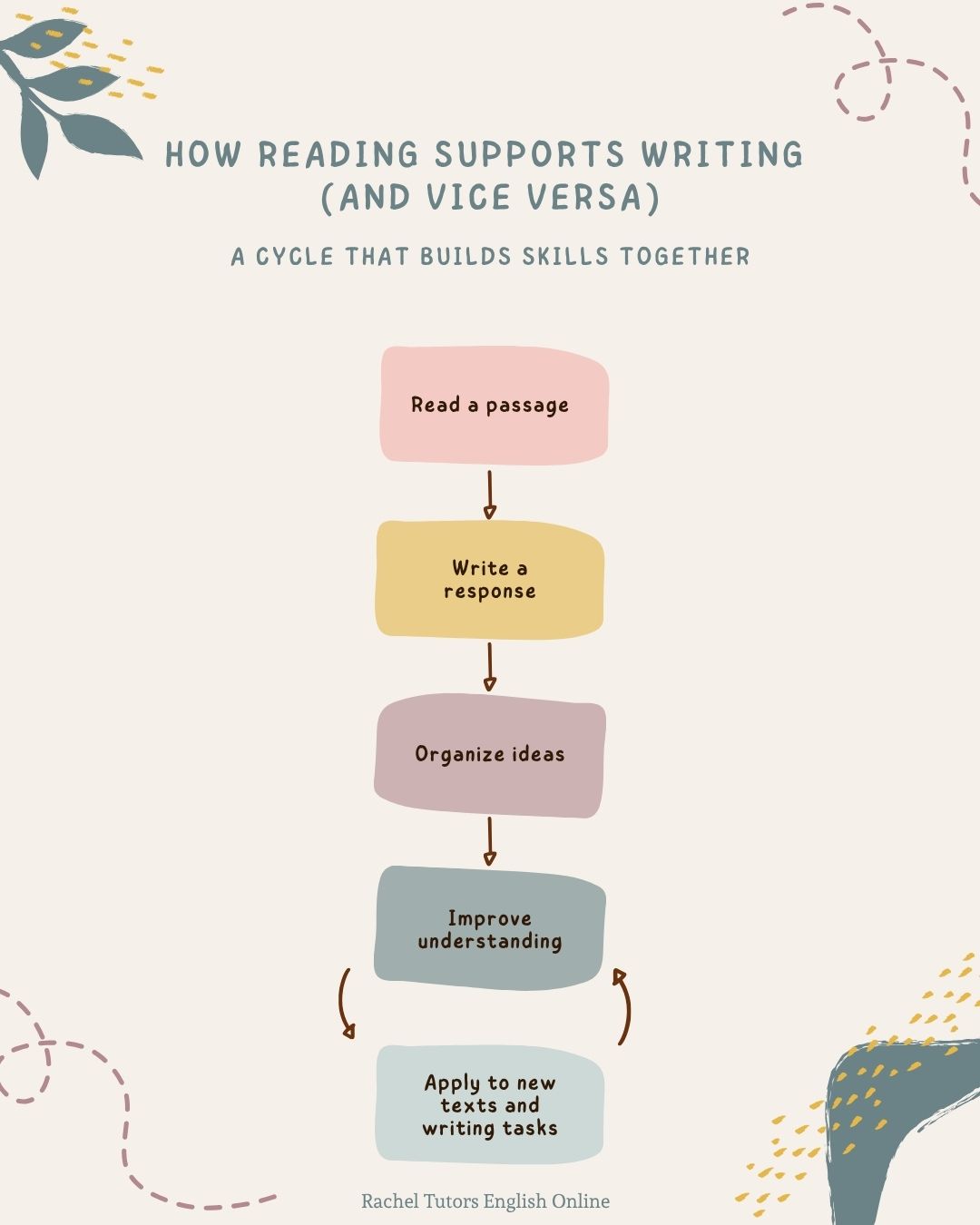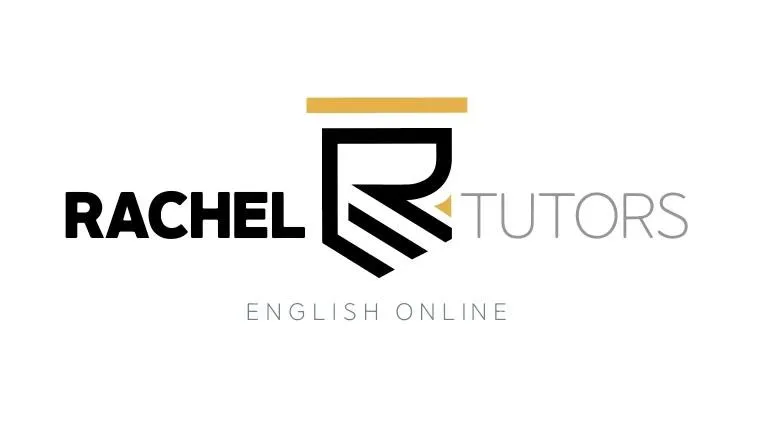Contact Us
Blog

How Reading Supports Writing (and Vice Versa): Why ELA Growth Happens When We Build Both
Introduction
Parents often reach out to me because their teen is struggling in English Language Arts, especially with writing. They ask for essay help, grammar support, or writing feedback, but sometimes they are surprised when I tell them we’ll also spend a good amount of time reading.
Here’s the truth: Reading and writing are not separate skills. They’re part of the same learning cycle.
When one is weak, the other usually is too.
And when one improves, the other gets stronger alongside it.
In Know Better, Do Better: Comprehension, David and Meredith Liben put it best: “Writing and reading need to coexist… They’re as linked as the breathing cycle.”
Backed by research and my own tutoring experience, this guide will walk you through exactly how reading and writing support each other, and what you can do to build both skills, at home and through tutoring.
📚 How Reading Helps Writing (More Than Most Teens Realize)
Many students don’t even realize they’re learning how to write better when they read. They think they’re just trying to finish a book. But with the right approach, every page is a writing lesson in disguise.
Here’s what regular reading gives students that directly strengthens their writing:
✍️ 1. Sentence Structure and Grammar Awareness
When students read well-written books, articles, and essays, they naturally absorb:
How complex and simple sentences are balanced
How punctuation creates rhythm
What good transitions look like
Even students who say “I hate grammar” begin to recognize correct structure just by reading regularly.
🔗 Related: 5 Ways to Improve Writing Skills Every Teen Needs to Try Today
✍️ 2. Stronger Vocabulary Choices
Good writers not only know more words, but they also understand the right word to use. Reading exposes teens to richer, more precise language than conversation alone can offer.
Struggling writers often rely on vague or overused words. Reading shows them how authors:
Use strong verbs instead of adverbs
Choose precise language for tone
Build nuance through word choice
Want to help your teen build a more confident vocabulary?
🔗 Read: How to Develop a Better Vocabulary: 5 Simple but Proven Strategies
✍️ 3. Structure and Organization of Ideas
Every strong piece of writing (whether it’s a blog post, literary analysis, or college essay) has a structure.
Students who read often start to recognize and replicate:
Introductions that hook
Clear argument development
Paragraph transitions
Logical conclusions
Even in fiction, these skills show up: how a story builds, how character arcs evolve, and how a theme is reinforced.
🧠 Why Writing Improves Reading Comprehension
Now let’s flip the script: Writing about what they read is one of the BEST ways to boost a student’s reading comprehension.
Here’s why:
📖 1. Writing Forces Students to Slow Down and Process
Many students read quickly but shallowly. When they have to write a summary, analysis, or opinion, they are forced to pause and ask:
What was this about?
What mattered?
What do I actually think about it?
This shift from passive intake to active processing helps them understand and retain more.
🔗 Related: 5 Eye-Opening Reasons Why Writing Is Important for Students
📖 2. Writing Builds Critical Thinking and Interpretation
When students write about a character’s motivation or compare two texts, they’re practicing the exact skills schools and exams demand:
Citing evidence
Drawing conclusions
Making inferences
These skills not only improve comprehension but help teens across all subjects, not just ELA.
📖 3. Writing Makes Comprehension Visible
If you’re not sure whether your teen really understood what they read, don’t ask them to explain it verbally. Ask them to write about it.
Even a one-paragraph summary can show:
What they focused on
Whether they understood the main ideas
If they can express the information clearly
Writing is a built-in comprehension check.
🔗 Related: Why Do Students Struggle with Reading Comprehension?
🧑🏫 Why I Always Link Reading and Writing in Tutoring
In my tutoring sessions, even when parents ask for just writing help, I include reading activities and vice versa. Here’s a glimpse of what my sessions look like:
💬 We Read and Discuss
We don’t just “assign reading.” We talk about it. Students are encouraged to:
Ask questions
Make predictions
Talk through confusing parts
This builds critical thinking before they write, so their responses are deeper and more confident.
📝 We Write in Response to Reading
Whether we’re reading a dystopian short story or an article on teen mental health, students write:
Quick summaries
Personal reactions
Character analyses
Argumentative responses
These exercises build both literary understanding and academic writing skills at the same time. They go beyond simply checking off a box by practicing the exact type of reading-based writing schools expect.
🔗 Related: What Do I Do to Help Struggling Readers and Writers with Online Language Arts Tutoring?
🛠 We Scaffold the Process
Many teens struggle with organizing their ideas, especially when they’re asked to go from reading a text to writing about it. In my sessions, I support students by breaking that process into manageable steps while gradually helping them become more independent.
Here’s what that looks like:
We talk first. I ask general comprehension questions to check basic understanding, then shift into deeper ones, often starting with why or how, or focusing on character motives and emotions.
I break big questions into smaller parts. If a student gets stuck, I guide them step by step to help them think critically without handing them the answer.
Sometimes we skip straight to writing. For students who need space to process on their own, I let them explore their ideas independently and write without discussion first.
We brainstorm together. We do a brain dump of everything they’re thinking, then sort through their ideas and choose the strongest ones for their response.
I remind them to let their evidence speak. Any quote or textual detail they choose should clearly support the point they’re making. It shouldn’t need a long explanation to make sense.
I teach paragraph structure before moving to essays. Students learn how to write topic sentences and make sure every other sentence in the paragraph supports that idea without drifting off-topic.
I model first, then step back. For first-time assignments, I walk them through the writing process. With each new assignment, I give a little less help until they can write independently.
I adjust based on the student. If they need more hand-holding, I stay close. If they’re ready for a challenge, I push them with higher-level prompts or deeper questions.
I differentiate by ability. For students who struggle, I simplify tasks and focus on building confidence. For average or advanced students, I nudge them just beyond their comfort zone to keep them growing.
Once students learn how to connect their reading to their writing, they not only write better, but they also understand texts more deeply and build lasting academic confidence.
🔗 Related: Start Implementing These Reading and Writing Tips for Middle Schoolers Today
Here’s a quick visual of how reading and writing support each other in a cycle—just like we practice in sessions:

🏡 A Simple Strategy to Try at Home
Want to build these skills at home without formal lessons?
Try this once a week: Read – Write – Talk
Have your teen read a short story, article, or chapter
Ask them to write 3–5 sentences about it (summary, opinion, favorite part)
Talk about what they wrote and ask why they chose that part, or ask if anything confused them
This easy routine builds:
Comprehension
Writing fluency
Confidence
🔗 Related: Parents, Here’s How to Motivate Students to Read at Home
😓 What Happens When These Skills Aren’t Taught Together?
Many schools separate reading and writing instruction, especially with test prep or rigid pacing guides.
When this happens, students:
Struggle to use evidence in essays
Can’t organize their thoughts about what they read
Don’t enjoy reading because they don’t understand it deeply
Can’t express opinions clearly, even when they have good ideas
These aren’t "student motivation" problems. They’re skill integration problems.
💬 Common Parent Questions I Hear
Q: Why are you spending time on reading when we signed up for writing help?
A: That’s a great question, and I get it often. Reading and writing go hand in hand. When we work on reading comprehension, we’re also building your teen’s foundation for stronger, more organized writing. The better a student understands what they’ve read, the clearer and more insightful their writing becomes.
Q: My teen does well in reading but still struggles to write clearly. Why?
A: Reading is part of the equation, but writing is a skill that needs direct instruction and ample practice. Even strong readers sometimes struggle to organize their thoughts or explain their ideas clearly. That’s where we focus on structure, clarity, and evidence-based writing.
✅ Final Thoughts
If you’ve been wondering whether to focus on reading or writing, the real answer is both. They grow together and should be taught together.
Reading gives students models, structure, and language.
Writing strengthens their comprehension, confidence, and expression.
Whether at home or in a tutoring session, the best progress happens when these skills are integrated, not isolated.
Ready to support both at once? I’d love to help. Let’s talk about how tutoring can strengthen your teen’s reading and writing, together.

